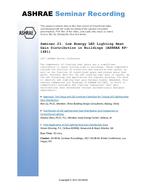Thermal comfort is affected by several environmental components, namely radiant asymmetry, air temperature, relative humidity, and air motion. Earlier research resulted in a methodology that incorporates mean radiant temperature into thermal comfort calculations. This steady-state methodology, referred to as the Building Comfort Analysis Program (BCAP), predicts the effect of radiative and convective heat transfer rates on the occupant based on design inputs of room geometry, radiative and convective heating systems, and outdoor design conditions, but does not include the complete effect of windows on thermal comfort predictions.
The objective of this research project is to develop a window model that accurately accounts for the transmission of long and short wave radiation from low and high temperature radiant heaters. The objective is to develop a stand-alone model that can be implemented in a variety of modular energy programs. The methodology, similar in scope to the BCAP methodology, will be used to incorporate the effect of window glass wavelength dependency on human thermal comfort calculations. The methodology must consider the wavelength dependency of glass, as well as the temperature of the energy source. The methodology should incorporate the effect of window transmissivity into the calculated mean radiant and operative temperature fields throughout a room as a function of time and space, and include the effects of room geometry, outdoor temperature conditions, and the size and location of radiative and convective heating systems.
Product Details
- Published:
- 2003
- File Size:
- 1 file , 2.7 MB
- Product Code(s):
- D-21506


